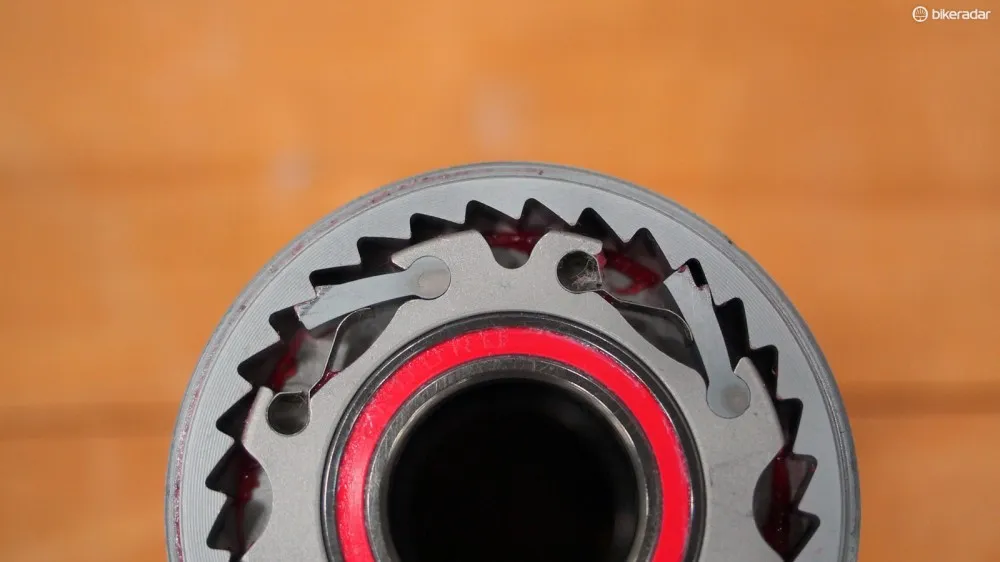South Carolina-based wheelset company Boyd Cycling has announced at this year's North American Handmade Bicycle Show its own range of lightweight road hubsets called Eternity. The clever design features ultra-wide bearing and spoke flange spacing along with one-piece axles that span both dropouts from end-to-end. Claimed weight is just 326g for the set while the rear hub’s internal layout also cuts bearing friction roughly in half.
Both the front and rear Eternity hubs have notable features but the biggest news resides out back.
The vast majority of modern four-bearing rear hubs use the same layout with one cartridge at either end of the hub shell to support the axle, and then two more way out on the driveside for the freehub body. Much like Easton has done with its new Echo hubs, however, Boyd’s new Eternity rear hub instead supports the axle at the very ends, which puts less stress on the axle and, at least in theory, yields a stiffer wheel overall.

Instead of supporting the axle primarily at the non-driveside end and roughly in the middle, the new Eternity hubset pushes the main axle bearings all the way out to the ends
The freehub body spins on its own pair of cartridge bearings as usual but not directly on the main axle like with conventional hubs. As on the Easton, the Eternity freehub rotates around its own completely separate, extra-oversized stub axle. In this case, Boyd uses a precision-machined aluminum tube that is screwed into the hub shell whereas Easton integrates the extension as part of the hub shell itself.
In addition to providing better axle support, this so-called ‘Dual Axle Design’ also brings with it a big bonus feature: greatly reduced drag. Since the freehub body bearings rotate on a stub axle that’s rigidly screwed into the hub shell, they only spin when the rider is coasting. This means that only two main axle bearings are in motion while pedaling, which cuts the bearing drag roughly in half without having to resort to costly ceramics.

Since the freehub body rotates on its own stub axle that is connected to the hub shell, only two bearings are spinning when the rider is pedaling
Even the freehub body itself is worthy of mention. Rather than machine it out of aluminum (which is light but prone to scarring from cassette cogs), Boyd uses titanium driver made with a proprietary injection molding process. According to company owner Boyd Johnson, this not only makes for a more durable part but one that’s more economical to produce than one with traditional manufacturing techniques while also generating less waste.
“It’s just like injection molding plastic but with titanium,” he said. “It’s 99.5 percent done straight out of the mold.”
That freehub body is then fitted with two pairs of slightly offset pawls, which combine with the 32-tooth ratchet ring to yield an impressively quick 5.6-degree engagement speed (faster than most mountain bike hubs).

Offset pawls and a 32-tooth ratchet ring yield a responsive 5.6-degree engagement speed
Both the front and rear hubs have a few additional features that Johnson claims to improve wheel stiffness and durability.
Instead of using end caps that lightly press into shortened axles, Boyd uses one-piece oversized aluminum axles that extend all the way from dropout to dropout. Both hubs use angular contact cartridge bearings, too, which are pushed far out near the ends of the axle and are more tolerant of side load than typical radial cartridges. Meanwhile, threaded collars allow for perfect bearing adjustment.
Johnson has also pushed the spokes far apart for better bracing angles, with 80mm between the front hub flanges and 56mm out back. For comparison, DT Swiss’s widely used 240s hubs measure 70mm and 50mm, respectively.

One-piece axles span the full width of the fork tips and rear dropouts, thus eliminating the potential flex of slide-fit end caps
Boyd Cycling will build the new Eternity hubs into a revamped range of complete wheelsets. Front wheels will be built with radial spokes while the rears will be laced two-cross on both sides. Johnson says that the rear spoke tension could have been further evened out with a two-to-one lacing pattern but not without a performance cost.
“I like double-crossing both sides,” he said. “I’m a bigger fan of torque transfer than tension balance. I think it feels better. If you radial lace one side, you take away 15 percent of your torque transfer. Reynolds and Zipp have both gone away from radial lacing on the rears.”
Boyd plans to sell the standalone Eternity hubset aftermarket, too, and is also open to doing custom designs for other wheel brands (including two-to-one lacing). Retail price is a rather hefty US$580 but that’s inline with other made-in-USA hubs such as those from Industry Nine.

Eternity hubs will be built into complete Boyd Cycling wheelsets but they will also be available aftermarket
For now, Eternity will only be available in quick-release fitments but Johnson says thru-axle versions are currently in development and should be done later this year.
For more information, visit www.boydcycling.com.












